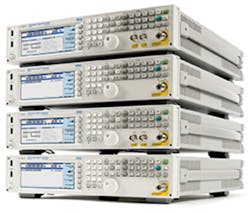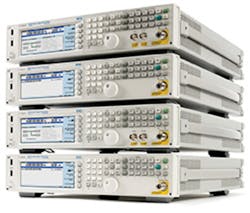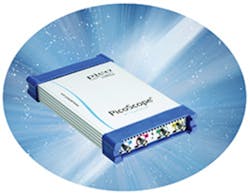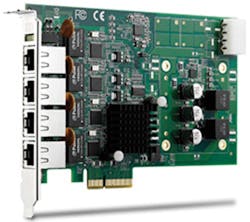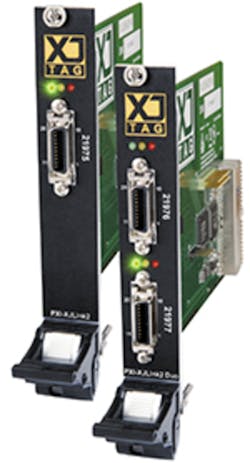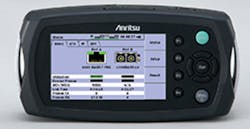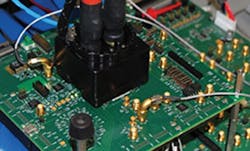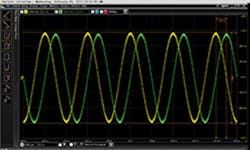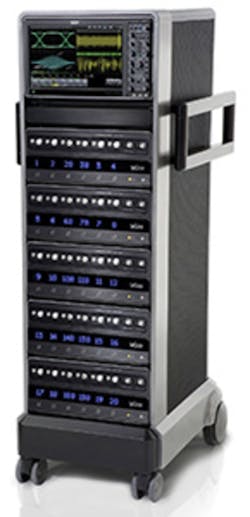6-GHz Signal Generators
While the moderately priced EXG employs a single-loop design, the MXG uses a triple-loop synthesizer to deliver phase noise performance of -146 dBc/Hz at 1 GHz and 20 kHz offset, enabling it to provide the signals needed to test aerospace/defense enhanced radar designs. For developers of radar components such as mixers and ADCs, the MXG also features spurious performance of -96 dBc at 1 GHz.
For designers developing faster data streaming in 802.11ac devices, the MXG offers factory-equalized 160-MHz RF bandwidth and ±0.2 dB flatness. Both the MXG and EXG deliver low EVM, output power up to +27 dBm, and ACPR of up to -73 dBc. From $6,900 for the EXG N5171B Analog Signal Generator to $19,320 for the MXG N5182B Vector Signal Generator.
USB Oscilloscopes
The PicoScope oscilloscope software supports serial decoding, mask limit testing, segmented memory, and advanced triggers. Running on a Windows PC, PicoScope provides a large, clear display that allows zooming and panning under keyboard or mouse control. Other built-in features are persistence displays with fast waveform update rates, math channels, automatic measurements with statistics, programmable alarms, and decoding of I2C, UART/RS232, SPI, CAN, and LIN bus signals. Triggering modes include pulse width, interval, window, window pulse width, level dropout, window dropout, runt pulse, variable hysteresis, and logic. A free software development kit can control the scopes from any custom application.
Quad-Port PoE Frame Grabber
The GIE64+ support for IEEE 1588 includes a software trigger mode for multicamera synchronized captures. Combining IEEE 1588 and PoE function, the GIE64+ utilizes one Ethernet cable for power supply, data transfer, and synchronization. In a typical four-channel image system, the GIE64+ requires four cables rather than the conventional 12. In addition, the GIE64+ also accommodates a PoE application programming interface enabling easy power status programming and auto detection of compatibility with both PoE and non-PoE devices.
PXI Boundary-Scan Modules
Bluetooth Low-Energy Test Set
The N4010A Test Set with the Bluetooth low-energy Tx/Rx option gives manufacturers and designers a method for testing Texas Instruments’ Bluetooth low-energy ICs. Bluetooth low-energy technology enables long operational life with minimal power consumption for applications such as mobile communications, sports and fitness, healthcare, security, and home entertainment. The tester supports TI’s single- and dual-mode solutions.
The N4010A delivers a multiformat test solution for WLAN, Bluetooth, and ZigBee applications in R&D, integration and verification, or manufacturing environments. It works with nonsignaling measurement test cases in external PC-hosted software.
Modules for Optical Network Test
The MU909014C/15C features a dynamic range of up to 38 dB. The dynamic range as well as the µOTDR’s enhanced midrange pulse widths allow the MT9090A modules to deliver better resolution and sampling of 2 cm, eliminating the need to test at multiple wavelengths. The µOTDRs also offer up to 250,000 data points and dead zones of <1 meter.
USB DAQ Module
The DT9862S offers two 16-bit simultaneous analog channels, two optional analog outputs, 32 DIO lines, two counter/timers, three quadrature decoders, and ±500-V galvanic isolation. A full range of software options including Windows XP/Vista/7-compatible drivers is available at no charge. The DT9862S ships installed in a metal connection box with SMA connectors or as a board-level OEM version. From $3,650.
LCR Meter
The E4982A is compatible with the current 4287A LCR Meter while offering greater performance. SCPI commands and a handler interface function for the E4982A also work with the 4287A LCR Meter, allowing customers to leverage earlier investments and expertise in the software. The E4982A provides PC connectivity via GPIB, LAN, and USB; an intuitive user interface; a 10.4” display; and a compact design with 277-mm depth. From $31,487 for 1-MHz to 3-GHz frequencies.
Triaxial Connectors
TRB bayonet-style connectors are used for quick-connect applications. TRT threaded coupling connectors are designed for applications requiring enhanced performance. Both series will withstand immersion in water for four hours at a 10-meter depth.
Triaxial connectors commonly are used in industrial, broadcast, and medical applications, including nuclear-medicine camera cables where reduced noise or interference levels are required and to ensure accurate measurements in medical dosimeter systems. Intelliconnect Triax connectors are double screened to ensure EMC integrity.
Thermal Management for ICs
The three main components of the thermal-management system are the thermal socket lid, the chiller, and the controller. The chiller supplies chilled liquid to the thermal socket lid. The controller has a constant feedback to monitor the thermal socket lid and supply the necessary electrical input to control the temperature.
The thermal socket lid transfers heat to the IC and compresses the IC on the interconnect unit. It replaces the actual socket lid on top of a test socket and has a replaceable compression plate to accommodate various IC sizes. An additional accessory called a socket frame interfaces the thermal socket lid to the socket body. From $3,987 in unit quantities.
1.5-GHz Spectrum Analyzer
The DSA815 Spectrum Analyzer with all-digital IF technology covers a frequency range of 9 kHz to 1.5 GHz and features a compact design and easy-to-use interface. The spectrum analyzer has a typical displayed average noise level (DANL) of -135 dBm, offset phase noise of -80 dBc/Hz at 10 kHz, and a total amplitude uncertainty of <1.5 dB. The DSA815 includes AM/FM demodulation and a preamplifier plus a variety of optional enhancements such as an EMI filter and a quasi-peak detector kit and a 1.5-GHz tracking generator.
Rigol’s digital IF design technology offers users the ability to measure smaller signals by enabling smaller bandwidth settings, reducing the displayed average noise level. With a minimum resolution bandwidth of 100 Hz, Rigol’s digital IF filter can distinguish between small signals close in frequency. From $1,295.
Hall-Effect Sensors
With a wide programmable magnetic range, the MLX92221 and MLX92241 both feature Hall-effect sensing elements operating from 2.7 V to 24 V voltage levels, addressing automotive, consumer, and industrial applications. These devices integrate protection mechanisms to guard against ESD, reverse supply voltage, and thermal overload.
Melexis Microelectronic Integrated Systems
Multi-TAP JTAG for ICT
The QuadTAP/CFM is a four-channel JTAG hardware platform that seamlessly integrates boundary-scan test capabilities into Teradyne in-circuit testers. The QuadTAP/CFM is designed for use with Teradyne TestStation and GR228x Series Testers. The platform provides independently adjustable TAP interface voltages from 1.25 V to 3.3 V, 100-MHz test-clock rates for boundary-scan test support, compatibility with IEEE 1149.6 AC-coupled digital networks, and in-system programming of flash and CPLD devices.
The QuadTAP/CFM is a single-slot custom functional module form-factor board that installs directly into one of four slots on a Teradyne multifunction application board. Integration is simple and transparent once installed in the system. Up to eight signals of the QuadTAP/CFM are available to test fixtures and the tester backplane. Additional signals are available using the included expander modules, which install into additional board slots.
Scope Analysis Application
InfiniiView migrates a full-featured real-time oscilloscope user interface to a PC for rapid navigation and powerful viewing/analysis. It offers up to 1,680 x 1,200 display resolution for better waveform viewing with large monitors and separate dockable windows for time, frequency, and protocol measurements for user-customizable views. In addition, the application provides transportable and server-based licensing to facilitate sharing. From $750 for the base software; upgrades and a free 14-day trial license are available.
65-GHz Real-time Bandwidth Scope
The modular oscilloscope architecture separates the oscilloscope signal-acquisition function from the display, control, and processing functions. The instrument’s MCM-Zi Master Control Module contains the display, controls, ChannelSync architecture, and a server-class CPU.
The 10 Zi acquisition modules provide silicon-based 36-GHz performance with up to 65 GHz on two channels. One 10 Zi master control module and one 10 Zi acquisition module function as a single conventional four-channel 36-GHz oscilloscope or as a conventional two-channel 65-GHz and four-channel 36-GHz scope. However, by using the ChannelSync architecture, up to 20 10 Zi acquisition modules can be synchronized, extending the channel density by a factor of 20 to achieve up to 80 channels at 36 GHz and 40 channels at 65 GHz. From $355,000.
Audio/Video Test Platform
The platform accommodates up to eight test modules. Separate options are available for the high-definition multimedia interface (HDMI) and the mobile high-definition link interface. An analog audio/video interface module and a modulator module for broadcasting standards currently are under development.
In combination with the HDMI options—which also are new—the VTC performs real-time analyses of video and audio parameters as well as info frames. To test sources and sinks, the VTC can perform system protocol tests in-line with the latest HDMI compliance test specification 1.4c. For the various interfaces, the company provides software that can automate test routines. The R&S VT-B2361 HDMI RX option also makes it possible to test ultra-definition resolutions, such as resolutions up to 4k x 2k used in high-end screens.
CMOS Image Sensor
The 2.14-megapixel Dynamax CMOS Image Sensor is a high-speed, high-definition sensor with more than 130-dB on-chip dynamic range in either the global-shutter or rolling-shutter mode. The device is a 2/3” HDTV format sensor with 5.0-micron square pixel technology. It offers a menu of features including the vendor’s patented Active Column Sensor technology, which achieves reduced noise levels at high gain settings; the patented Correlated Multi-Sampling technology to further reduce noise or add gain; dual rolling or global shutter integration for intraframe, on-chip high dynamic range imaging; dual words per pixel for dual gain per pixel; and a single- or dual-row readout option with more than 500-fps performance and region-of-interest support.
Dynamax 2.14Mp engineering-grade devices currently are available in a CLCC package in either color or monochrome versions. High-volume production is planned in the Q4 2012.
